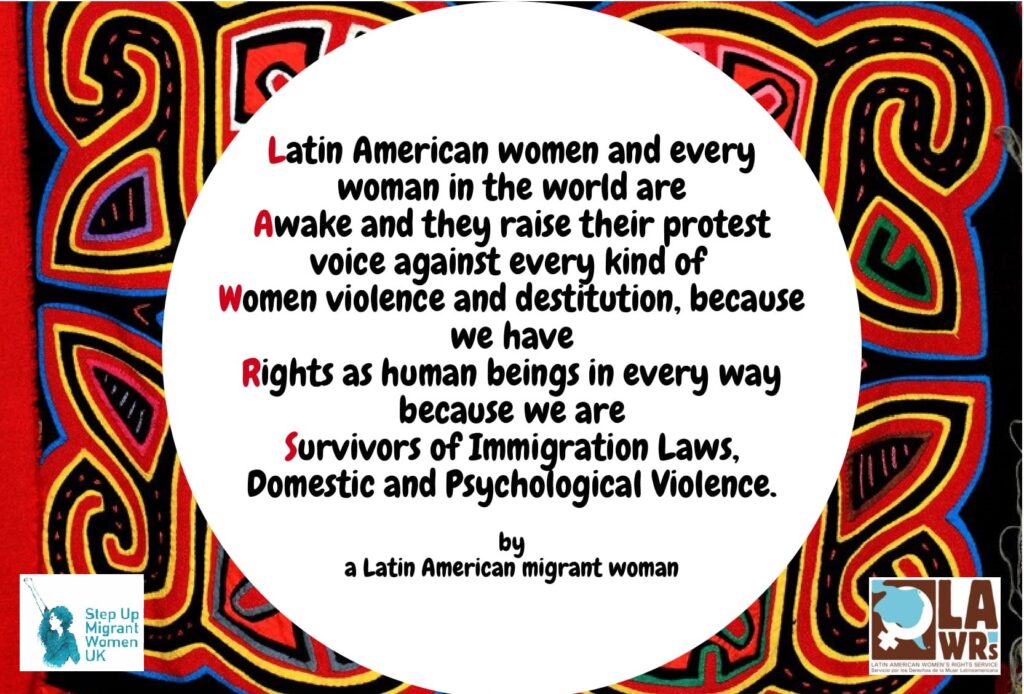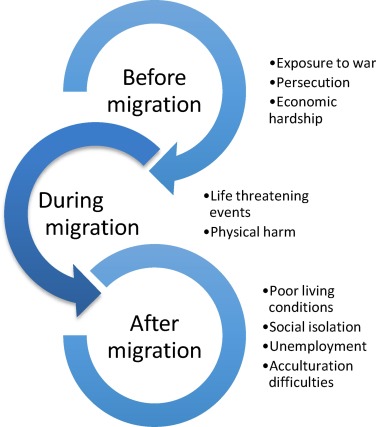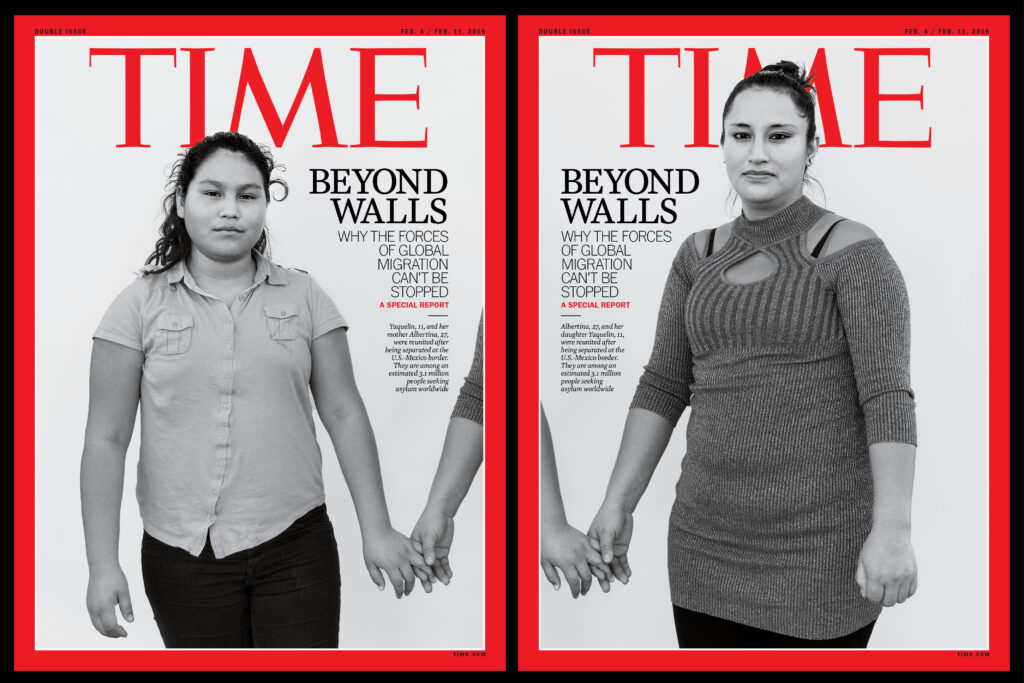This post begins with a poem that was written by a Latin American immigrant as part of a series titled “Sharing Our Voice Through Poetry” and published by Step Up Migrant Women UK, an organization that advocates for migrant women to receive help from abuse.

The women who wrote this poem, a survivor of gender violence, voices her resilience to the traumas she has experienced. It is vital that migrant women who have experienced migration and gender-related trauma have access to appropriate mental health treatment, services, and support, so that they do not have to suffer in silence.
Introduction
Globally, a record number of women are on the move. Nearly half of the 277 million migrant population are women. Many women migrate for reasons that are gender related. They may migrate due to economic necessity, to escape domestic violence, to seek greater educational opportunities, or to seek other opportunities not available in their country of origin. However, gender does not only influence migrant’s reasons for migrating. The risks, vulnerabilities, and needs associated with the migration experience are shaped by gender as well. Migrating comes with various accompanying stressors that can deeply affect women and their families. In this post, we’ll learn to understand migration and its impacts on the mental health of migrant women.
Why Do Women Migrate?
As it was alluded to in the introduction, women choose to leave their country of origin for various reasons. There is no single, comprehensive explanation for immigration. However, it is worth trying to explain why women migrate, as it can help us to understand broader political, economical, and social contexts within these women’s lives. Several notable migration theorists have developed frameworks on the determinants of immigration. One of the earliest and most widely recognized of these theorists is Ernest Ravenstein, who developed the “Laws of Migration” (Massey et al. 1993). He proposed that migration is determined by a “push-pull” process. Meaning, the reasons that people migrate are determined by push and pull factors; they are “pushed” by unfavorable conditions that cause them to leave their home, and “pulled” by favorable conditions that attract them to a certain destination.

Ravenstein established the groundwork in migration theory, and many later theorists have developed variations of his “Laws of Migration”. One of those theorists was Everett Lee, who proposed that there are intervening obstacles that have an impact on the immigration process (Massey et al. 1993). Intervening obstacles influence how an immigrant responds to push-pull factors, and can be things like and can be things like age, social class, and gender. More contemporary theorists examine the determinants of female immigration solely, suggesting for example, “the integrative approach” to female migration (Oishi, 2002). The integrative approach looks at women’s reasons for migration on a macro-level (the state), micro-level (individuals), and meso-level (society). This perspective helps us to understand how individual women make their decision to immigrate, as it takes into account the various structures, for instance, the state, personal level of autonomy, social environment, ect. that may prohibit or enable a woman to migrate. While no single theory can comprehensively explain why women immigrate, these theories are helpful in understanding the various factors that influence the process of migration.
The Migration Experience
It is important to consider the various processes and factors that influence migration, so that we can begin to understand the migration experience. When we use the term “migration experience”, we are referring to the fact that different reasons for leaving one’s country of origin will produce different outcomes. For example, a Syrian woman leaving her country as a political refugee will have a migration experience that is different from a Latina woman from Mexico who is immigrating to the United States. Both women will have different reasons for leaving their homeland, they will have different risks, vulnerabilities, and needs associated with their migration, and they will adjust to their new environments differently.
This is relevant as we try to understand migration and its impacts on mental health, as a woman’s migrant experience has a role in their mental health and wellbeing, pre- and post-migration. As we look at migrations’ impact on mental health challenges, we can consider the ‘migration experience”, and examine the different reasons a woman has for migrating, the social, political, and environmental conditions in which migrants live, and the way that the woman is adapting to changes in her new location.
In Their Own Words: "Why Do Women Migrate?" and the Migration Experience
To better understand the various determinants of migration and the migration experience, here are the stories of two young migrants. Hearing their experiences can enable us to comprehend more complex perspectives on migrant’s lives. Their stories come from Justice for Immigrants, a campaign founded by the United States Conference of Catholic Bishops.


The woman on the left is Giovanna Oaxaca. When she was a young child, her parents left their home in Juarez, Mexico seeking a better life in the United States. Her parents made the decision to leave following the economic crisis in their city, as well as an overall increase in poverty and crime. In 2011, in an attempt to visit her ailing grandmother, who still lived in Mexico, Giovanna’s mother was detained and deported. Giovanna believes the most difficult part of her migration experience was the suffering she felt from being seperated from her loved ones.
The woman on the right is Lidia*. She came to the United States from San Pedro Sula, Honduras. She made the decision to leave San Pedro Sula, because of lack of educational opportunities, fear of being discriminated against for her sexuality, and abuse from her family and others as a child. Her biggest hurdle in life has been recovering from the physical and emotional scars from being trafficked. Now that she is in the United States, she is working to become healthy and overcome some of the trauma from her past, so that she can live her life fully, work, and become more independent.
*Lidia’s name and photo was changed by Justice for Immigrants for safety reasons.
The Impact of Immigration on Mental Health
Now that the determinants of migration and the migration experience have been established, we can begin to be conscious of the connection between migration and the mental health of migrants. We know that immigrants experience unique stressors that push them to leave their country of origin. While many women migrating may be leaving their country to improve their wellbeing, the actual process of migration itself can cause or exaberaberate mental health problems. The accompanying stressors of migration can deeply affect the individual migrating. When examining the stress factors that can influence a migrants mental health, it is helpful to categorize them into pre-migration factors, migration factors, and post-migration factors (Wessels, 2014).
Some of the pre-migration factors that influence migrant’s mental health are:
- Poverty and other related economic hardships: One researcher who looked at quality of life among Mexican immigrants in the United States, found that immigrants who lived in poverty before migration are susceptible to chronic stress, increased risk for exposure to trauma, and the development of PTSD (Perreira & Ornelas, 2014).
- Parent-Child Separation: It has been estimated that approximately one-third of Latin American-born children stay in their country of origin for at least one year before being reunited with their parents in the United States. This family separation increases the overall stress of migration, can have effects on attachment anxiety, and results in higher incidences of PTSD after exposure to trauma. (Santa-Maria & Cornille, 2007).
- Previous Encounters of Gender Violence: According to data collected from the International Displacement Monitoring Center, in 2013, 18,800 women were displaced from Mexico, Guatemala, El Salvador, and Honduras due to gender-based violence, and about ⅓ of these women were between the age 12-17. Mental impacts for women who have encountered gender-based violence include things like PTSD, depression, anxiety, substance misuse, as well as stigma and rejection from one’s family and/or community.
Some of the migration factors that influence migrant’s mental health are:
- Physical danger and sexual violence: Many women who seek to get through the Mexico border rely on smugglers. Research that involved interviewing women from Corning, Mexico, a migrant transit city, found that many women reported being abused, exploited, robbed, and abandoned by smugglers as they attempted to cross the border (Kelley, 2019).
Some of the post-migration factors that influence migrant’s mental health are:
- Limited language use and ability: A 2008 study found that Hispanic immigrants in America who had limited English proficiency were linked to poor health outcomes (Alegria, Alvarez & DiMarzio, 2008). When immigrants have limited language proficiency or require interpreters, this can limit their access to healthcare services, including mental healthcare services.
- Encounters with discrimination, racism, and bias: Immigrants who experience discrimination and other related stressors are at a greater risk for psychiatric disorders, suicidal behaivors, and depression symptoms (Alegria, Alvarez & DiMarzio, 2008).
- Stress associated with the resettlement process: Many immigrants struggle to maintain transnational ties after their migration, that is, maintain social and cultural ties with their country of origin. A study from 2015 found that women who had higher numbers of visits back home, had an increased risk of depressive episodes. (Alcántara & Alegría, 2015).
Below is a graphic that was created by a group of researchers studying the prevalence of and risk factors for migrants. It describes some of the pre-migration factors, migration factors, and post-migration factors that can have an impact on mental health, as well as illustrate the way that the effects of these factors carry over throughout the entire migration process to create increasingly difficult, multi-layered circumstances.

In Their Own Words: The Impact of Migration on Mental Health
To help us better understand the factors that influence migrant mental health, here is the story of one migrant woman and her daughter. Their story came from an article in Time Magazine, titled The Stories of Migrants Risking Everything for a Better Life.

Above is a picture of Albertina Contreras and her 11-year old daughter. She and her daughter traveled to the United States from their home in Cubulco, Guatemala. The circumstances of her migrant experience capture some of the pre-migration factors and post-migration factors described previously. Pre-migration, Albertina was a victim of physical and sexual violence, telling Time Magazine that she had been repeatedly raped and beaten by men in her town, and feared the same would happen to her daughter as she grew older. Additionally, she presents another pre-migration factor, poverty, as she describes needing to borrow $6,000 in order for her to complete the trip. Post-migration, as Albertina arrived in the United States, she was detained and separated from her daughter for more than a month. In the article, she describes the immense pain of not even knowing where her daughter was. Her first day in a new country, she immediately encountered racism, discrimination, and bias, recounting people telling her, “You’re illegal. What are you doing in our country? You know they’re going to deport you”, as well as being called “animals” by U.S.Customs and Border Patrol agents. Albertina recalls that when she finally did get on the phone with her daughter weeks later, all she could do was cry. Arguably, the stress involved with Albertina’s history of physical and sexual violence, her economic hardships, her encounters her anti-immigration rhetoric, and her forced separation from her daughter, could have a complex effect on her and even her daughter’s mental health, causing or exacerbating mental health difficulties.
Barriers to Mental Health Services for Migrant Women
Now that we’ve established that migrants are exposed to a variety of stress factors that can influence their mental health, it’s worth noting some of the challenges in providing mental health care to migrants. Before getting into those, it should be stressed that the most prominent barrier to receiving mental health treatment is that globally, migrant’s rights to health services are severely limited. For instance, in the state of California, where more undocumented women live than anywhere else in the country, federally-funded mental health care only covers undocumented women who are pregnant (California Health Report, 2019). Even in communities where mental health care services are available to all women, migrants may still be reluctant to seek resources due to a variety of barriers. One of these barriers are conflicting gender roles. As many migrant women begin to adjust to a new country, they are simultaneously working and managing family responsibilities. Migrant women may feel that they are unable to seek mental healthcare due as they are preoccupied with taking on multiple, and sometimes unfamiliar roles. Migrant women may also not seek treatment due to the stigmatization of mental healthcare. Research on gender influences of immigrant women’s mental health found that migrant women who had strong commitments to home chores and childcare were more apprehensive about seeking help (Delara, 2016). They reported that they felt if they had to accept mental health care services or treatment, that they would be betraying their family and family roles. On a more general level, another one of these barriers are language related. It can be difficult for migrants to learn the primary language of their new home, which can impact their ability to communicate with others, making things like mental health consultations and assessments difficult. A second barrier are cultural expectations. Migrants may not know what to expect from mental healthcare, or may lack knowledge about available mental healthcare services, preventing them from getting a diagnosis and proper treatment if needed. A third barrier is establishing trust. The experiences of some migrants may lead them to be distrustful or wary of authorities and services. This, combined with a limited understanding of how healthcare works in their new country, can make some migrants fearful or apprehensive to seek help.
Below is a graphic that was created by the Institute for Clinical Evaluative Sciences to illustrate immigrant women’s uses of postpartum health services. As the graphic explains, immigrant women are less likely to seek mental health care, in part, due to a complex range of barriers, similar to the ones that were explained above.

The Impact of Mental Health Services to Migrant Women
As we’ve seen, there are a wide range of barriers to providing mental health care to migrant women. The impact of these barriers is dependent on factors like the country of origin of the migrant women, the amount of time the woman has been in her new country, the extent to her social networks, among other factors. Having barriers to mental health services means that migrant women potentially face issues such as delayed access to health assessments, treatment, and care. These issues damage women’s health, and perpetuate disparities in the distribution of health resources. Migrant women’s status make them especially vulnerable to the effects of mental health service barriers. For instance, women in detention centers, places that generally have limited access to appropriate mental health care, are at an additional risk. One study found that detention centers are directly linked to diminished physical and mental health. This, like many other barriers, is completely out of migrant women’s control. When migrant women’s right to mental health care is restricted by barriers, their broader health needs are ignored, and the impacts often extend over families and entire communities. It’s vital that migrant women who have experienced trauma and stressors before, during, and after their migration experience are connected to mental health care support and services.
Implementing Mental Health Care to Migrant Women
The needs of migrant women need to be addressed so that they can be better served by mental health departments in their communities. The longer that their needs remain unaddressed, the more mental health disparities become exacerbated.There are ways that barriers to mental health care can be overcome. It’s important that changes to migrant women’s mental health care include examining the social determinants of their mental health and giving women access to the services they need. The most effective way to do this is with a holistic approach that addresses the determinants of mental health at social and individual standpoints (Delara, 2016). This can be done on multiple levels. On the level of mental health practices, practitioners need to be aware of the negative impact that migration can have on a woman’s mental health. They need to be mindful of the experiences of migrant women pre-migration, migration, and post-migration. Practitioners should make every effort to establish trusting relationships with their clients who are migrant women, ensuring for example, undocumented women, that seeking mental health treatment will have no impact on their ability to qualify to become documented citizens. Mental health professionals working in a wide range of areas, individual and group therapy, support groups, inpatient and outpatient care, hospitalization, ect, should be educated in ways that include diversity building, so that they can properly treat women from diverse ethno-cultural backgrounds. On the level of policy, more funding and resources are necessary to ensure that the needs of migrant women can be met. Additionally, existing policies regarding migrants should be adjusted to address mental health issues that are gender-specific. Other actions can be taken on a more local level, such as making efforts to include migrant women in policy development, advocacy groups, and nonprofit organizations. By implementing recommendations like these, migrant women may find women-centered mental health care more accessible.
Implementing Mental Health Care to Migrant Women: Significant Organizations
The current reality is that many migrant women will not receive needed mental health services for a variety of reasons. In response to this, several nonprofit organizations have been formed with the goal of providing appropriate treatment and services to migrant’s who need it. These organizations extend globally. They include:
Immigrant Women’s Support Services: A government-funded organization based in Australia that began in 2013. This organization offers free, confidential, and culturally-sensitive emotional support to migrant women and their children who have experience domestic and/or sexual violence. They offer things like counseling, referrals, crisis-support, case-management, and other related services.

Refugee Mental Health Resource Network: A U.S. based organization that connects volunteer psychologists and mental health professionals with refugees worldwide. In 2018, they began responding to the mental health crisis at the Mexico-U.S. border, sending clinicians, researchers, and advocates to support families suffering from the family separation policy.

Refugee Trauma Initiative: A restricted fund-nonprofit that began in Thessaloniki, Greece. The organization offers psycho-social support to refugees of all ages who are dealing with the trauma of conflict and displacement. Their main goals are to help refugees integrate into their new communities and to help them overcome adversity.

Data and Research Conclusion
Gender influences every stage of the migration process. It influences a woman’s reasons for migrating, how she migrates, and her opportunities at every destination. It also shapes her risks, needs, and vulnerabilities. Women have various motives for migrating, but the practice is generally related to the struggle for a better life, and a desire to improve their wellbeing and overall condition. However, the migration experience can be an immensely stressful process at all stages, with the potential to adversely affect mental health. Exposure to traumatic events and stressors before, during, and after migration can cause or exacerbate mental health problems. There’s evidence that after migrating, migrant women face difficulties in using and accessing mental health treatment and services. Barriers to these services make women apprehensive to seek out help when needed. It’s vital that these barriers are identified and addressed from a gendered-perspective, so that migrant women can better express their needs, access appropriate care, and exercise their right to affordable, appropriate, good quality mental health care.
Below is a brief educational video that was created by undergraduate students at McMaster University in Ontario, Canada. It illustrates the refugee mental health crisis and potential approaches to address it. While it is not from a gendered perspective, this video summarizes some of the details that were described in this blog post, and will hopefully help let this topic resonate with you.
Self Reflection
I wanted to conclude this blog post by mentioning that throughout the process of researching and writing on this topic, I could not help but reflect on my own positionality. When I began to look at research materials, I initially felt a little discomfort or doubt in the arguments that some of the researchers made. I soon realized that my privilege in relation to this topic was impacting the way that I was framed by research. I started to consider how aspects of my own identity, my class, gender, ethnicity, race, shaped my perspective throughout the whole process of learning about this topic and completing this project. My orientation towards mental health care is positive, and this prior knowledge can have an effect on my research and writing. When I became more reflexive and sensitive towards the experiences of migrant women, I discovered that I was able to read and interpret sources on migrant women’s experiences with trauma and mental health care in ways that were considerate of both the similarities and differences between myself and migrant women.
References
Alcántara, C., Chen, C.-N., & Alegría, M. (2015). Transnational ties and past-year major depressive episodes among Latino immigrants. Cultural Diversity and Ethnic Minority Psychology, 21(3), 486–495. https://doi.org/10.1037/a0037540
Alegría, Margarita, Kiara Álvarez, and Karissa DiMarzio. “Immigration and Mental Health.” Curr Epidemiol Rep 4, no. 2 (2017). https://doi.org/10.1007/s40471-017-0111-2.
Delara, Mahin. “Social Determinants of Immigrant Women’s Mental Health.” Advances in Public Health, 2016. https://doi.org/https://doi.org/10.1155/2016/9730162.
Edwards, Haley. “A Close Look at Migration and the People Risking Everything.” Time. Time, January 24, 2019. https://time.com/longform/migrants/.
“Faces of Migration.” Justice for Immigrants, July 26, 2020. https://justiceforimmigrants.org/faces-of-migration/stories-of-migration/.
Giacco, Domenico, Neelam Laxham, and Stefan Priebe. “Prevalence of and Risk Factors for Mental Disorders in Refugees.” Unit for Social and Community Psychiatry (WHO Collaborating Centre for Mental Health Service Development), 2017. https://doi.org/10.1016/j.semcdb.2017.11.030.
ICESONTARIO. “Immigrant women in Ontario get much less #mentalhealth care after giving birth, but have similar risk of mental health hospitalization as non-immigrants.” 12 December 2017, 1:57 p.m.. Twwet
“Immigrant Women’s Support Service.” Immigrant Womens Support Service RSS. Accessed December 9, 2020. http://www.iwss.org.au/.
“Immigrants and Health in California.” Public Policy Institute of California, May 13, 2019. https://www.ppic.org/publication/immigrants-and-health-in-california/.
Kelly, Matt. “Road Fraught with Danger for Female Migrants, UVA Student Research Finds.” UVA Today, February 8, 2019. https://news.virginia.edu/content/road-fraught-danger-female-migrants-uva-student-research-finds.
Massey, Douglas S., Joaquin Arango, Graeme Hugo, Ali Kouaouci, Adela Pellegrino, and J. Edward Taylor. “Theories of International Migration: A Review and Appraisal.” Population and Development Review 19, no. 3 (1993): 431-66. Accessed December 9, 2020. doi:10.2307/2938462.
Oishi , Nana. “Gender and Migration: An Integrative Approach .” The Center for Comparative Immigration Studies , 2002.
Perriera, Krista, and India Orneleas. “Painful Passages: Traumatic Experiences and Post-Traumatic Stress among Immigrant Latino Adolescents and Their Primary Caregivers.” Int Migr Rev 47, no. 4 (2013). https://doi.org/10.1111/imre.12050.
Refugee Mental Health Resource Network. Accessed December 9, 2020. https://refugeementalhealthnet.org/.
Refugee Trauma Initiative. Accessed December 9, 2020. https://www.refugeetrauma.org/.
Santa-Maria, Maria L., and Thomas Cornille. “Traumatic Stress, Family Separations, and Attachment Among Latin American Immigrants.” Traumatology 13, no. 2 (June 2007): 26–31. https://doi.org/10.1177/1534765607302278.
Sakhi, Saba. “Recent Immigration Policies Negatively Affect Women.” Legal Momentum, July 17, 2018. https://www.legalmomentum.org/blog/recent-immigration-policies-negatively-affect-women.
“Sharing Our Voices Through Poetry.” Step Up Migrant Women, May 11, 2018. https://stepupmigrantwomen.org/2018/05/11/voicing-our-voices-through-poetry/.
Wessels, Whitney K. “The Refugee Experience: Involving Pre-Migration, In Transit, and Post Migration Issues in Social Services .” Social Work Commons, 2014.
